For example, a 10 kg mass has a different
weight on the moon than it does on Earth. According to Newton’s Second Law, the
weight of a 10 kg mass on Earth is
F = mgearth
= (10kg)(9.8m/s2)
= 98N
This force is directed toward the center of the Earth. On the moon, the acceleration
due to gravity is roughly one-sixth that on Earth. Therefore, the weight of a 10 kg mass
on the moon is only about 16.3 N toward the center of the moon.
The Normal Force
The normal force always acts perpendicular (or “normal”) to the surface
of contact between two objects. The normal force is a direct consequence of
Newton’s Third Law. Consider the example of a 10 kg box resting on the floor.
The force of gravity causes the box to push down upon the ground with a force,
W, equal to the box’s weight.
Newton’s Third Law dictates that the floor must apply an equal and opposite
force, N = –W, to the box. As a result, the
net force on the box is zero, and, as we would expect, the box remains at rest.
If there were no normal force pushing the box upward, there would be a net force
acting downward on the box, and the box would accelerate downward
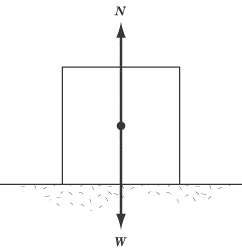
Be careful not to confuse the normal force vector N with the abbreviation for newtons, N.
It can be a bit confusing that both are denoted by the same letter of the alphabet,
but they are two totally different entities.
Example
A person pushes downward on a box of weight W with a force F.
What is the normal force, N, acting on the box?
The total force pushing the box toward the ground is W + F. From Newton’s Third Law,
the normal force exerted on the box by the floor has the same magnitude as W + F but is
directed upward. Therefore, the net force on the box is zero and the box remains at rest.
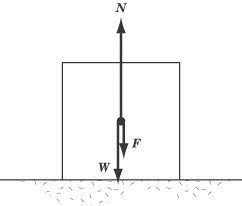
Friction
Newton’s First Law tells us that objects in motion stay in motion unless a force
is acting upon them, but experience tells us that when we slide coins across a
table, or push boxes along the floor, they slow down and come to a stop. This is
not evidence that Newton was wrong; rather, it shows that there is a force
acting upon the coin or the box to slow its motion. This is the force of
friction, which is at work in every medium but a vacuum, and is the bugbear
of students pushing boxes across the sticky floors of dorm rooms everywhere.
Roughly speaking, frictional forces are caused by the roughness of the materials
in contact, deformations in the materials, and molecular attraction between
materials. You needn’t worry too much over the causes of friction, though: SAT
II Physics isn’t going to test you on them. The most important thing to remember
about frictional forces is that they are always parallel to the plane of contact
between two surfaces, and opposite to the direction that the object is being
pushed or pulled.
There are two main types of friction: static friction and kinetic
friction. Kinetic friction is the force between two surfaces moving relative
to one another, whereas static friction is the force between two surfaces that
are not moving relative to one another.
Static Friction
Imagine, once more, that you are pushing a box along a floor. When the box is at
rest, it takes some effort to get it to start moving at all. That’s because the
force of static friction is resisting your push and holding the box in place.
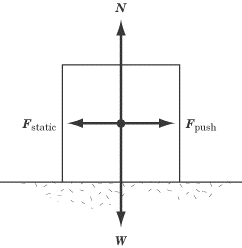
In the diagram above, the weight and the normal force are represented as
W and
N respectively, and the force
applied to the box is denoted by
Fpush.
The force of static friction is represented by
Fstatic,
where
Fstatic = Fpush.
The net force on the box is zero, and so the box does not move. This is what
happens when you are pushing on the box, but not hard enough to make it budge.
Static friction is only at work when the net force on an object is zero, and
hence when
Fstatic = -Fpush.
If there is a net force on the object, then that object will be in motion, and
kinetic rather than static friction will oppose its motion.
Kinetic Friction
The force of static friction will only oppose a push up to a point. Once you
exert a strong enough force, the box will begin to move. However, you still have
to keep pushing with a strong, steady force to keep it moving along, and the box
will quickly slide to a stop if you quit pushing. That’s because the force of
kinetic friction is pushing in the opposite direction of the motion of the box,
trying to bring it to rest.
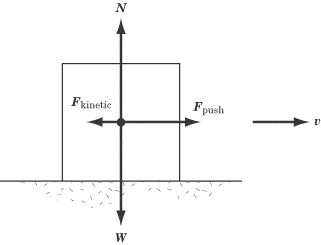
Though the force of kinetic friction will always act in the opposite direction of
the force of the push, it need not be equal in magnitude to the force of the
push. In the diagram above, the magnitude of
Fkinetic
is less than the magnitude of
Fpush.
That means that the box has a net force in the direction of the push, and the
box accelerates forward. The box is moving at velocity
v in the diagram, and will
speed up if the same force is steadily applied to it. If
Fpush
were equal to
-Fkinetic,
the net force acting on the box would be zero, and the box would move at a
steady velocity of v, since
Newton’s First Law tells us that an object in motion will remain in motion if
there is no net force acting on it. If the magnitude of
Fpush
were less than the magnitude of
Fkinetic,
the net force would be acting against the motion, and the box would slow down
until it came to a rest.
The Coefficients of Friction
The amount of force needed to overcome the force of static friction on an
object, and the magnitude of the force of kinetic friction on an object, are
both proportional to the normal force acting on the object in question. We can
express this proportionality mathematically as follows:

where Uk is the coefficient of kinetic friction, Uk is the coefficient of static friction,
and N is the magnitude of the normal force. The coefficients of kinetic and static friction
are constants of proportionality that vary from object to object.
Note that the equation for static friction is for the maximum value of the static friction.
This is because the force of static friction is never greater than the force pushing on
an object. If a box has a mass of 10 kg and U5 = 0.5, then:
Fstatic, max = 0.5(10kg)<9.8m/s2)
= 49 N
If you push this box with a force less than 49 newtons, the box will not move,
and consequently the net force on the box must be zero. If an applied force is
less Fpush thanFstatic,max ,
then Fstatic = –Fpush.
Three Reminders
Whenever you need to calculate a frictional force on
subject test Physics, you will be told the value of µ , which will fall
between 0 and 1. Three things are worth noting about frictional forces:
- The smaller µ is, the more slippery the surface. For instance, ice will have
much lower coefficients of friction than Velcro. In cases where µ , the force of friction
is zero, which is the case on ideal frictionless surfaces.
- The coefficient of kinetic friction is smaller than the coefficient
of static friction. That means it takes more force to start a stationary
object moving than to keep it in motion. The reverse would be illogical:
imagine if you could push on an object with a force greater than the maximum
force of static friction but less than the force of kinetic friction.
That would mean you could push it hard enough to get it to start moving,
but as soon as it starts moving, the force of kinetic friction would push it backward.
- Frictional forces are directly proportional to the normal force.
That’s why it’s harder to slide a heavy object along the floor than a
light one. A light coin can slide several meters across a table because
the kinetic friction, proportional to the normal force, is quite small.
Example
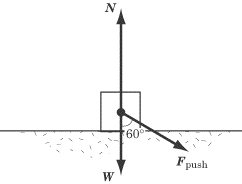
A student pushes a box that weighs 15 N with a force of 10 N at a 60Å angle to
the perpendicular. The maximum coefficient of static friction between the box and the floor
is 0.4. Does the box move? Note that sin 60º = 0.866 and cos 60Š= 0.500.
In order to solve this problem, we have to determine whether the horizontal
component of
Fpush
is of greater magnitude than the maximum force of static friction.
We can break the
Fpush
vector into horizontal and vertical components. The vertical component will push
the box harder into the floor, increasing the normal force, while the horizontal
component will push against the force of static friction. First, let’s calculate
the vertical component of the force so that we can determine the normal force,
N, of the box:
Fpush y = Fpush cos60° = 0.500 (10N) = 5.0 N
If we add this force to the weight of the box, we find that the normal force
is 15 + 5.0 = 20 N. Thus, the maximum force of static friction is:
Fstatic,max = µN = 4.0(20N) = 8.0N
The force pushing the box forward is the horizontal component of Fpush , which is:
Fpush x = Fpushsin60° = 0.866(10N) = 8.66N
As we can see, this force is just slightly greater than the maximum
force of static friction opposing the push, so the box will slide forward.
Tension
Consider a box being pulled by a rope. The person pulling one end of the
rope is not in contact with the box, yet we know from experience that the box
will move in the direction that the rope is pulled. This occurs because the force
the person exerts on the rope is transmitted to the box.
The force exerted on the box from the rope is called the tension force,
and comes into play whenever a force is transmitted across a rope or a cable.
The free-body diagram below shows us a box being pulled by a rope, where W is
the weight of the box, N is the normal force, T is the tension force, and Ff is
the frictional force.
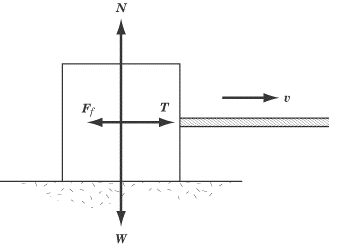
In cases like the diagram above, it’s very easy to deal with the force of
tension by treating the situation just as if there were somebody behind the box
pushing on it. We’ll find the force of tension coming up quite a bit in the chapter
on special problems in mechanics, particularly when we deal with pulleys.
Back
Next
Next to display next topic in the chapter.
Practice Questions
Video Lessons and 10 Fully Explained Grand Tests
Large number of solved practice MCQ with explanations. Video Lessons and 10 Fully explained Grand/Full Tests.